Dunfermline: Difference between revisions
m clean up, typos fixed: 240 acre → 240-acre |
No edit summary |
||
| Line 15: | Line 15: | ||
|constituency=Dunfermline and West Fife | |constituency=Dunfermline and West Fife | ||
}} | }} | ||
'''Dunfermline''' is a | '''Dunfermline''' is a city in [[Fife]], standing on high ground three miles from the northern shore of the [[Firth of Forth]]. It is a former capital of the Kingdom of Scotland; seat of the royal court and an important ecclesiastical centre. Dunfermline Abbey is the burial place for many kings, including Robert I and Saint Margaret; Malcolm III's English queen. Dunfermline received [[List of cities in the United Kingdom|city status]] by Letters Patent on 3 October 2022.<ref>{{cite web |title=King Charles visits Scotland: Dunfermline granted city status|url=https://www.heraldscotland.com/politics/23015443.king-charles-visits-scotland-dunfermline-granted-city-status/ |access-date=3 October 2022}}</ref> | ||
Dunfermline is full of history and draws visitors to admire its attractions. Here are the ruins of Dunfermline's abbey, and the remains of the Royal Palace of Dunfermline, birthplace of King Charles I. | Dunfermline is full of history and draws visitors to admire its attractions. Here are the ruins of Dunfermline's abbey, and the remains of the Royal Palace of Dunfermline, birthplace of King Charles I. | ||
Since the early 20th century, the most famous son of Dunfermline has been the wealthy industrialist, businessman, and philanthropist Andrew Carnegie. He never forgot his | Since the early 20th century, the most famous son of Dunfermline has been the wealthy industrialist, businessman, and philanthropist Andrew Carnegie. He never forgot his home town; he was the central figure in promoting its early 20th-century urban renewal and he richly endowed the town. | ||
Today, the | Today, the city serves as a major service centre for western Fife area. Dunfermline has three museums, two theatres, large public parks (Pittencrieff and St Margaret's), a swimming pool and sports centre, three golf courses, major shopping facilities and a regional leisure park which includes a multiplex cinema, a ten-pin bowling alley and a variety of restaurants. The Carnegie College is based in the city with its main campus at Halbeath. | ||
Traditional industries of the town have included textiles, engineering, defence and electronics. In recent years the economy has diversified once more into the service sectors, including tourism. According to an estimate taken in 2008, Dunfermline has a population of 46,430, making it the second-largest settlement in Fife. The wider Dunfermline conurbation which includes [[Rosyth]], [[Inverkeithing]] and [[North Queensferry]] has an overall population of 78,550. Employment today is mainly in the service sector, the largest employer being BSKYB. | Traditional industries of the town have included textiles, engineering, defence and electronics. In recent years the economy has diversified once more into the service sectors, including tourism. According to an estimate taken in 2008, Dunfermline has a population of 46,430, making it the second-largest settlement in Fife. The wider Dunfermline conurbation which includes [[Rosyth]], [[Inverkeithing]] and [[North Queensferry]] has an overall population of 78,550. Employment today is mainly in the service sector, the largest employer being BSKYB. | ||
| Line 49: | Line 49: | ||
Post-war housing began in the late 1940s with the construction of temporary prefabs and Swedish timber houses around areas such as Kingseat and Townhill. Additional provisions were made for electricity, water and sewage systems. Council housing was focused towards Abbeyview, on a 240-acre site on Aberdour Road; Touch, to the south of Garvock Hill; Bellyeoman and Baldridgeburn. Private housing became focused to the north of Garvock Hill and on the site of West Pitcorthie Farm.<ref name="McEwan p87">McEwan ''Dunfermline: The Post-War Years'' p87</ref> | Post-war housing began in the late 1940s with the construction of temporary prefabs and Swedish timber houses around areas such as Kingseat and Townhill. Additional provisions were made for electricity, water and sewage systems. Council housing was focused towards Abbeyview, on a 240-acre site on Aberdour Road; Touch, to the south of Garvock Hill; Bellyeoman and Baldridgeburn. Private housing became focused to the north of Garvock Hill and on the site of West Pitcorthie Farm.<ref name="McEwan p87">McEwan ''Dunfermline: The Post-War Years'' p87</ref> | ||
==Sights about the | ==Sights about the city== | ||
[[File:Dunfermline Abbey - entrance.jpg|thumb|right|160px|Dunfermline Abbey]] | [[File:Dunfermline Abbey - entrance.jpg|thumb|right|160px|Dunfermline Abbey]] | ||
The '''Guildhall''' on the High Street was designed by Archibald Elliot and first erected in 1807.<ref name="Carnegie Trust p97">Dunfermline Carnegie Trust ''Our Heritage'' p.97.</ref> A steeple was later added between 1810 and 1811.<ref name="Carnegie Trust p97" /> Initially, the Guildhall had been built for Dunfermline to become the headquarters of Fife's council, before a decision was made to choose [[Cupar]] instead. Since then, the building has had several functions such as a police station, courthouse and even a jobcentre.<ref name="Carnegie Trust p97" /> The steeple on the Guildhall has been regarded as a local landmark. | The '''Guildhall''' on the High Street was designed by Archibald Elliot and first erected in 1807.<ref name="Carnegie Trust p97">Dunfermline Carnegie Trust ''Our Heritage'' p.97.</ref> A steeple was later added between 1810 and 1811.<ref name="Carnegie Trust p97" /> Initially, the Guildhall had been built for Dunfermline to become the headquarters of Fife's council, before a decision was made to choose [[Cupar]] instead. Since then, the building has had several functions such as a police station, courthouse and even a jobcentre.<ref name="Carnegie Trust p97" /> The steeple on the Guildhall has been regarded as a local landmark. | ||
| Line 59: | Line 59: | ||
'''Abbot House''' stands to the north of the abbey, situated on the corner of the May Gate and Abbot Street, a Category A building.<ref name="Carnegie Dunfermline Trust pp13–16">Carnegie Dunfermline Trust ''Dunfermline: Our Heritage'' pp.13–16.</ref><ref name="Abbot House listing">{{cite web |url=http://hsewsf.sedsh.gov.uk/hslive/hsstart?P_HBNUM=25978 |title=Abbot House — Listed Building Report |publisher=Historic Scotland |accessdate=2011-02-17}}</ref> This is said to date in parts from around 1450.<ref name="McEwan p13">McEwan Bert ''Dunfermline Post War Years'' p.13.</ref> Owned and operated by Dunfermline Carnegie Trust, the building is now an award-winning heritage centre which was opened in 1995.<ref name="Carnegie Dunfermline Trust pp13–16" /><ref name="McEwan p13" /><ref name="Pride pp12–13">Pride ''Kingdom of Fife'' pp.12–13.</ref> Along Abbot Street, the first Carnegie Library in the world, the Category B<ref name="Carnegie library listing">{{cite web |url=http://hsewsf.sedsh.gov.uk/hslive/hsstart?P_HBNUM=25979 |title=Dunfermline Carnegie Library — Listed Building Report |publisher=Historic Scotland |accessdate=2011-02-17}}</ref> listed Dunfermline Carnegie Library, was built between 1881 and 1883.<ref name="Gifford p188">Gifford ''Buildings of Fife'' p.188.</ref> | '''Abbot House''' stands to the north of the abbey, situated on the corner of the May Gate and Abbot Street, a Category A building.<ref name="Carnegie Dunfermline Trust pp13–16">Carnegie Dunfermline Trust ''Dunfermline: Our Heritage'' pp.13–16.</ref><ref name="Abbot House listing">{{cite web |url=http://hsewsf.sedsh.gov.uk/hslive/hsstart?P_HBNUM=25978 |title=Abbot House — Listed Building Report |publisher=Historic Scotland |accessdate=2011-02-17}}</ref> This is said to date in parts from around 1450.<ref name="McEwan p13">McEwan Bert ''Dunfermline Post War Years'' p.13.</ref> Owned and operated by Dunfermline Carnegie Trust, the building is now an award-winning heritage centre which was opened in 1995.<ref name="Carnegie Dunfermline Trust pp13–16" /><ref name="McEwan p13" /><ref name="Pride pp12–13">Pride ''Kingdom of Fife'' pp.12–13.</ref> Along Abbot Street, the first Carnegie Library in the world, the Category B<ref name="Carnegie library listing">{{cite web |url=http://hsewsf.sedsh.gov.uk/hslive/hsstart?P_HBNUM=25979 |title=Dunfermline Carnegie Library — Listed Building Report |publisher=Historic Scotland |accessdate=2011-02-17}}</ref> listed Dunfermline Carnegie Library, was built between 1881 and 1883.<ref name="Gifford p188">Gifford ''Buildings of Fife'' p.188.</ref> | ||
'''Andrew Carnegie's birthplace''' stands on the east side of Moodie Street, close to the junction with Priory Lane and St Margaret's Street.<ref name="Carnegie Dunfermline Trust p21">Carnegie Dunfermline Trust ''Our Heritage'' p.21.</ref> The Category B<ref name="Carnegie's birthplace listing">{{cite web |url=http://hsewsf.sedsh.gov.uk/hslive/hsstart?P_HBNUM=25979 |title=Andrew Carnegie birthplace — Listed Building Report |publisher=Historic Scotland |accessdate=2011-02-17}}</ref> listed cottage from the early 18th century is now one of the only examples left to have been built for the employees of hand loom weavers in the town.<ref name="Carnegie Dunfermline Trust p21" /><ref name="MacKay p23">MacKay ''Little Boss: The Life of Andrew Carnegie'' p.23.</ref> A memorial hall was added in 1928 to adjoin the cottage.<ref name="Carnegie Dunfermline Trust p21" /> Today, this operates as a birthplace museum for the | '''Andrew Carnegie's birthplace''' stands on the east side of Moodie Street, close to the junction with Priory Lane and St Margaret's Street.<ref name="Carnegie Dunfermline Trust p21">Carnegie Dunfermline Trust ''Our Heritage'' p.21.</ref> The Category B<ref name="Carnegie's birthplace listing">{{cite web |url=http://hsewsf.sedsh.gov.uk/hslive/hsstart?P_HBNUM=25979 |title=Andrew Carnegie birthplace — Listed Building Report |publisher=Historic Scotland |accessdate=2011-02-17}}</ref> listed cottage from the early 18th century is now one of the only examples left to have been built for the employees of hand loom weavers in the town.<ref name="Carnegie Dunfermline Trust p21" /><ref name="MacKay p23">MacKay ''Little Boss: The Life of Andrew Carnegie'' p.23.</ref> A memorial hall was added in 1928 to adjoin the cottage.<ref name="Carnegie Dunfermline Trust p21" /> Today, this operates as a birthplace museum for the city's most famous son.<ref name="Carnegie Dunfermline Trust p21" /><ref name="MacKay p23" /> | ||
'''Bothwell Street Viaduct''' on Bothwell Street was built between 1874 and 1877, as a sandstone bridge by R Young and Son to carry the Edinburgh to Dunfermline Railway over the Bothwell Gardens Roundabout.<ref name="Gifford p191">Gifford ''Buildings of Fife'' p.191.</ref><ref name="Dunfermline Carnegie Trust p31">Dunfermline Carnegie Trust ''Our Heritage'' p.31.</ref> | '''Bothwell Street Viaduct''' on Bothwell Street was built between 1874 and 1877, as a sandstone bridge by R Young and Son to carry the Edinburgh to Dunfermline Railway over the Bothwell Gardens Roundabout.<ref name="Gifford p191">Gifford ''Buildings of Fife'' p.191.</ref><ref name="Dunfermline Carnegie Trust p31">Dunfermline Carnegie Trust ''Our Heritage'' p.31.</ref> | ||
| Line 71: | Line 71: | ||
'''Hill House''' to the south of Dunfermline was built in 1623 for William Monteith of Randford as a lairds' house.<ref name="Gifford p239">Gifford ''Buildings of Fife'' p.239.</ref><ref name="Dunfermline Carnegie Trust p17">Dunfermline Carnegie Trust ''Our Heritage'' p.17.</ref> | '''Hill House''' to the south of Dunfermline was built in 1623 for William Monteith of Randford as a lairds' house.<ref name="Gifford p239">Gifford ''Buildings of Fife'' p.239.</ref><ref name="Dunfermline Carnegie Trust p17">Dunfermline Carnegie Trust ''Our Heritage'' p.17.</ref> | ||
'''Pitreavie Castle''' is close to the southern end of the dual carriageway between the | '''Pitreavie Castle''' is close to the southern end of the dual carriageway between the city and [[Rosyth]].<ref name="Dunfermline Carnegie Trust pp168–171" /> It was built in 1631 as a fortified manor by Sir Hendry Wardlaw.<ref name="Dunfermline Carnegie Trust pp168–171" /> The castle has since been converted into luxury flats.<ref name="Lamont-Brown">Lamont-Brown ''Fife in History and Legend''</ref> | ||
'''Logie House''' to the south-west of Dunfermline was built for the Hunt family.<ref name="Gifford p315">Gifford ''Buildings of Fife'' p.315.</ref> | '''Logie House''' to the south-west of Dunfermline was built for the Hunt family.<ref name="Gifford p315">Gifford ''Buildings of Fife'' p.315.</ref> | ||
| Line 78: | Line 78: | ||
[[File:Carnegie Library, Dunfermline.jpg|right|thumb|160px|The Carnegie Library]] | [[File:Carnegie Library, Dunfermline.jpg|right|thumb|160px|The Carnegie Library]] | ||
[[File:Carnegie Hall - geograph.org.uk - 295515.jpg|right|thumb|200px|Carnegie Hall]] | [[File:Carnegie Hall - geograph.org.uk - 295515.jpg|right|thumb|200px|Carnegie Hall]] | ||
The | The city's most famous son is Andrew Carnegie. A museum dedicated to the life and work of Andrew Carnegie is located on the southern gateway of the city centre. The museum also runs annual heritage walks every summer.<ref name="Hendrie p30">Hendrie, William F. ''Old Dunfermline'' p. 30.</ref> Many of his donations to the town such as the Carnegie Swimming Baths (now the Carnegie Leisure Centre), the Carnegie Library and particularly, Pittencrieff Park were all intended to "bring into the monotonous lives of the toiling masses of Dunfermline more sweetness and light".<ref name="Hendrie p3" /><ref name="Pride pp12–13" /> | ||
Andrew Carnegie House which is located on the edge of Pittencrieff Park has served as the headquarters of the Dunfermline Carnegie Trust; the Carnegie Hero Fund; the Carnegie Trust for the Universities of Scotland and the Carnegie United Kingdom Trust since the completion of the building in 2008.<ref name="Andrew Carnegie House">{{cite web |url=http://www.scottisharchitecture.com/article/view/Andrew+Carnegie+House |title=Andrew Carnegie House |publisher=Scottish Architecture.com |accessdate=2008-13-02 |date=2010-12-16}}</ref> | Andrew Carnegie House which is located on the edge of Pittencrieff Park has served as the headquarters of the Dunfermline Carnegie Trust; the Carnegie Hero Fund; the Carnegie Trust for the Universities of Scotland and the Carnegie United Kingdom Trust since the completion of the building in 2008.<ref name="Andrew Carnegie House">{{cite web |url=http://www.scottisharchitecture.com/article/view/Andrew+Carnegie+House |title=Andrew Carnegie House |publisher=Scottish Architecture.com |accessdate=2008-13-02 |date=2010-12-16}}</ref> | ||
| Line 107: | Line 107: | ||
*[http://dunfermline.info/ Dunfermline online website] - Dunfermline on the web since 1996 | *[http://dunfermline.info/ Dunfermline online website] - Dunfermline on the web since 1996 | ||
*[http://www.scotcities.com/carnegie/early.htm Early Carnegie Libraries] - featuring the world's first Carnegie Library in Dunfermline | *[http://www.scotcities.com/carnegie/early.htm Early Carnegie Libraries] - featuring the world's first Carnegie Library in Dunfermline | ||
{{Cities in the United Kingdom}} | |||
Latest revision as of 19:57, 25 January 2023
| Dunfermline | |
| Fife | |
|---|---|
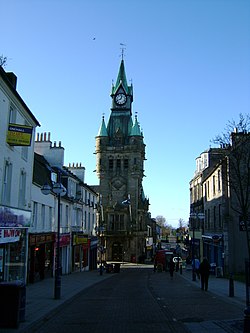 Dunfermline City Chambers | |
| Location | |
| Grid reference: | NT105875 |
| Location: | 56°4’19"N, 3°26’21"W |
| Data | |
| Population: | 46,430 (est) |
| Post town: | Dunfermline |
| Postcode: | KY11, KY12 |
| Dialling code: | 01383 |
| Local Government | |
| Council: | Fife |
| Parliamentary constituency: |
Dunfermline & West Fife |
Dunfermline is a city in Fife, standing on high ground three miles from the northern shore of the Firth of Forth. It is a former capital of the Kingdom of Scotland; seat of the royal court and an important ecclesiastical centre. Dunfermline Abbey is the burial place for many kings, including Robert I and Saint Margaret; Malcolm III's English queen. Dunfermline received city status by Letters Patent on 3 October 2022.[1]
Dunfermline is full of history and draws visitors to admire its attractions. Here are the ruins of Dunfermline's abbey, and the remains of the Royal Palace of Dunfermline, birthplace of King Charles I.
Since the early 20th century, the most famous son of Dunfermline has been the wealthy industrialist, businessman, and philanthropist Andrew Carnegie. He never forgot his home town; he was the central figure in promoting its early 20th-century urban renewal and he richly endowed the town.
Today, the city serves as a major service centre for western Fife area. Dunfermline has three museums, two theatres, large public parks (Pittencrieff and St Margaret's), a swimming pool and sports centre, three golf courses, major shopping facilities and a regional leisure park which includes a multiplex cinema, a ten-pin bowling alley and a variety of restaurants. The Carnegie College is based in the city with its main campus at Halbeath.
Traditional industries of the town have included textiles, engineering, defence and electronics. In recent years the economy has diversified once more into the service sectors, including tourism. According to an estimate taken in 2008, Dunfermline has a population of 46,430, making it the second-largest settlement in Fife. The wider Dunfermline conurbation which includes Rosyth, Inverkeithing and North Queensferry has an overall population of 78,550. Employment today is mainly in the service sector, the largest employer being BSKYB.
Well connected with the busy towns of Fife and beyond, Dunfermline lies on the northern spur of the "Fife Circle" rail line and the intersection of the M90 motorway and A92.
History
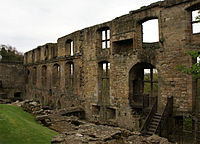
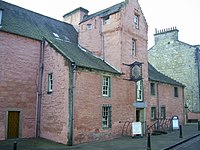
The first historical record for settlement in Dunfermline was around 506 AD as a centre for the Culdee monks. The first recorded name "Dunfermelitane" followed in 1128 by David II and the form officially adopted as "Dunfermline" in 1609.[2]
Malcolm III established Dunfermline as a new seat for royal power in the mid-11th century and initiated changes that eventually made the township the de facto capital of Scotland for much of the period until the assassination of James I in 1437.[3]
Malcolm's second Queen, the English princess Margaret, was instrumental in this transformation, persuading her husband to establish a Benedictine priory in the new royal centre.[3][4][5][6] This foundation, which in 1128 became Dunfermline Abbey, eventually replaced the long established Culdee church there and played a major role in the general Romanisation of religion throughout the kingdom. At the peak of its power the abbey controlled four burghs, three courts of regality and a large portfolio of lands from Moray in the north down into Berwickshire.[3] The royal palace was also connected to the abbey and the first known documentation of the Auld Alliance was signed there on 23 October 1295.
Dunfermline was first credited as a "menus burgh" by David II with evidence suggesting that burgh of barony status was bestowed between 1124 and 1147.[7] Royal burgh status was then granted by James VI in 1588.[4][8]
The Reformation of 1560 meant a loss of the Dunfermline's ecclesiastical importance. The Union of the Crowns ended the town's royal connections when James VI brought the Scottish court to London in 1603.[4][5] In 1624 a major fire left a large part of the mediæval-renaissance burgh in ruin. Some of the surviving buildings of the fire were the palace, the abbey and the Abbot's House.[3][4][9]
Charles I, the King of England, Scotland and Ireland from 1625 to 1649 was born in Dunfermline Palace. His father, James VI and I and his Queen, Anne of Denmark, lived in the town until 1603.
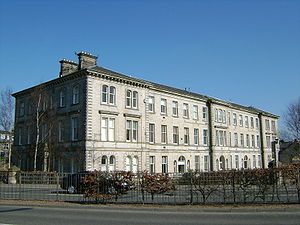
Although the town "impressed" Daniel Defoe as showing the "full perfection of decay", it was in fact beginning to recover a little of its former prosperity in the 18th century. James Blake introduced the weaving of fine damask linen in 1718 and the town became the world's leading producer.[4][5][8][10] The most imposing of the linen damask factories was St Leonard's Mill which was established by Erskine Beveridge in 1851. A warehouse and office block was later added around 1869. Other linen factories were built on land to both the north and south ends of the burgh.[11] During the mid-19th century, powerloom weaving started to replace linen damask. The latter did not survive, going into decline straight after the end of First World War.[4] The establishment of Scotland's only Royal Navy Dockland, in neighbouring Rosyth in 1909, boosted by two world wars, led to further growth in the town becoming the area's only major employer.[4][5]
Dunfermline's most famous son is the entrepreneur and philanthropist, Andrew Carnegie who was born in the town in 1835. Among the gifts he gave to his hometown, include a free library and public baths. Most important of all, was the donation of Pittencrieff Glen which he had purchased in 1903 to be converted into Pittencrieff Park.
Post-war housing began in the late 1940s with the construction of temporary prefabs and Swedish timber houses around areas such as Kingseat and Townhill. Additional provisions were made for electricity, water and sewage systems. Council housing was focused towards Abbeyview, on a 240-acre site on Aberdour Road; Touch, to the south of Garvock Hill; Bellyeoman and Baldridgeburn. Private housing became focused to the north of Garvock Hill and on the site of West Pitcorthie Farm.[12]
Sights about the city
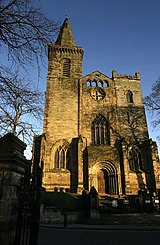
The Guildhall on the High Street was designed by Archibald Elliot and first erected in 1807.[13] A steeple was later added between 1810 and 1811.[13] Initially, the Guildhall had been built for Dunfermline to become the headquarters of Fife's council, before a decision was made to choose Cupar instead. Since then, the building has had several functions such as a police station, courthouse and even a jobcentre.[13] The steeple on the Guildhall has been regarded as a local landmark.
Dunfermline City Chambers at the corner of Bridge Street and the High Street were first built between 1879 and 1881 in a blend of French, Gothic and Scots baronial styles.[14]
Dunfermline Abbey is to the south of the High Street, on the Kirkgate. It is considered to be one of the best examples of Scoto-Norman monastic architecture.[15][16] Only the incomplete and much altered nave from the mediæval church survives.[15] Despite much being destroyed by war in 1303, there are substantial remains with the lower stories of the dormitory and latrine blocks on the east side of the cloister being the earliest surviving parts, dating back to the early 13th century.[16][17] The eastern section of the abbey was re-built as a parish church between 1818 and 1821.[16] The abbey graveyard has also been the burial site of many of Scotland's Kings and Queens such as David I, Malcolm IV and Robert I.
Abbot House stands to the north of the abbey, situated on the corner of the May Gate and Abbot Street, a Category A building.[14][18] This is said to date in parts from around 1450.[19] Owned and operated by Dunfermline Carnegie Trust, the building is now an award-winning heritage centre which was opened in 1995.[14][19][20] Along Abbot Street, the first Carnegie Library in the world, the Category B[21] listed Dunfermline Carnegie Library, was built between 1881 and 1883.[22]
Andrew Carnegie's birthplace stands on the east side of Moodie Street, close to the junction with Priory Lane and St Margaret's Street.[23] The Category B[24] listed cottage from the early 18th century is now one of the only examples left to have been built for the employees of hand loom weavers in the town.[23][25] A memorial hall was added in 1928 to adjoin the cottage.[23] Today, this operates as a birthplace museum for the city's most famous son.[23][25]
Bothwell Street Viaduct on Bothwell Street was built between 1874 and 1877, as a sandstone bridge by R Young and Son to carry the Edinburgh to Dunfermline Railway over the Bothwell Gardens Roundabout.[26][27]
St Leonard's Church and round tower, to the south of the viaduct on Brucefield Avenue, was built between 1903 and 1904.[28][29] The round tower with a conical roof is considered to be a landmark.[28][29]
The warehouse of the St Leonard's Works is found on the east side of Bothwell Street. The warehouse is the only surviving part of the St Leonard's Works, which was the first power-loom factory to be built in Dunfermline in 1851 and became the largest linen damask factory in Europe by the 1880s.
Pitfirrane Castle, once the seat of the Halkett family lies to the west of Dunfermline, close to the village of Crossford[30] The majority of the castle dates from the 16th century including the plain rectangular tower.[31] The castle and estate were purchased by the Dunfermline Carnegie Trust in 1951 and this has become the clubhouse for Dunfermline golf course.[30]
Hill House to the south of Dunfermline was built in 1623 for William Monteith of Randford as a lairds' house.[32][33]
Pitreavie Castle is close to the southern end of the dual carriageway between the city and Rosyth.[30] It was built in 1631 as a fortified manor by Sir Hendry Wardlaw.[30] The castle has since been converted into luxury flats.[34]
Logie House to the south-west of Dunfermline was built for the Hunt family.[35]
Culture
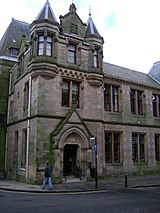
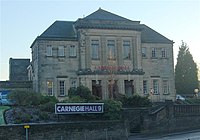
The city's most famous son is Andrew Carnegie. A museum dedicated to the life and work of Andrew Carnegie is located on the southern gateway of the city centre. The museum also runs annual heritage walks every summer.[36] Many of his donations to the town such as the Carnegie Swimming Baths (now the Carnegie Leisure Centre), the Carnegie Library and particularly, Pittencrieff Park were all intended to "bring into the monotonous lives of the toiling masses of Dunfermline more sweetness and light".[5][20] Andrew Carnegie House which is located on the edge of Pittencrieff Park has served as the headquarters of the Dunfermline Carnegie Trust; the Carnegie Hero Fund; the Carnegie Trust for the Universities of Scotland and the Carnegie United Kingdom Trust since the completion of the building in 2008.[37]
A new £10 million Dunfermline Museum and Art Gallery is to be built on land between the existing Carnegie library building and an adjacent disused Victorian bank.[38][39] Fife Council have pledged £6.8 million towards the project with a further £2.8 million of the costs being met by the Heritage Lottery Fund. Both the library and former bank buildings will be redeveloped with a new extension creating a substantial development which will include the museum, art gallery, archive and library space.[39] A section of the Victorian bank facade will be demolished and then rebuilt as a giant pivoting door to act as an entrance.[40] The work is expected to start by award-winning Edinburgh-based Richard Murphy Architects in 2012.[39]
Dunfermline has also been bequeathed two theatres, Carnegie Hall on East Port and the Alhambra on Canmore Street. Carnegie Hall which was built between 1933 and 1937, is a 540-seat theatre complete with a restaurant and adjacent music institute.[41]
Notes
- ↑ "King Charles visits Scotland: Dunfermline granted city status". https://www.heraldscotland.com/politics/23015443.king-charles-visits-scotland-dunfermline-granted-city-status/.
- ↑ Durie A Century of Dunfermline pp11–13
- ↑ 3.0 3.1 3.2 3.3 Lamont-Brown Fife in History and Legend pp.178–180.
- ↑ 4.0 4.1 4.2 4.3 4.4 4.5 4.6 Pride Kingdom of Fife pp.8–10.
- ↑ 5.0 5.1 5.2 5.3 5.4 Hendrie Old Dunfermline p.3.
- ↑ Civic Society, Kirkcaldy A History and Celebration p. 12.
- ↑ Omand The Fife Book p.136.
- ↑ 8.0 8.1 Lamont-Brown Fife in History and Legend p.186.
- ↑ Durie A Century of Dunfermline pp.16–17.
- ↑ Omand The Fife Book pp.188–189.
- ↑ Simpson The Auld Grey Toun - Dunfermline in the time of Andrew Carnegie 1835-1919 p.85.
- ↑ McEwan Dunfermline: The Post-War Years p87
- ↑ 13.0 13.1 13.2 Dunfermline Carnegie Trust Our Heritage p.97.
- ↑ 14.0 14.1 14.2 Carnegie Dunfermline Trust Dunfermline: Our Heritage pp.13–16.
- ↑ 15.0 15.1 Walker and Ritchie Fife, Perthshire and Angus p.129.
- ↑ 16.0 16.1 16.2 Fife Regional Council Mediæval Abbeys and Churches in Fife Fife Regional Council p.16.
- ↑ Lamont-Brown Fife in History and Legend p.182.
- ↑ "Abbot House — Listed Building Report". Historic Scotland. http://hsewsf.sedsh.gov.uk/hslive/hsstart?P_HBNUM=25978. Retrieved 2011-02-17.
- ↑ 19.0 19.1 McEwan Bert Dunfermline Post War Years p.13.
- ↑ 20.0 20.1 Pride Kingdom of Fife pp.12–13.
- ↑ "Dunfermline Carnegie Library — Listed Building Report". Historic Scotland. http://hsewsf.sedsh.gov.uk/hslive/hsstart?P_HBNUM=25979. Retrieved 2011-02-17.
- ↑ Gifford Buildings of Fife p.188.
- ↑ 23.0 23.1 23.2 23.3 Carnegie Dunfermline Trust Our Heritage p.21.
- ↑ "Andrew Carnegie birthplace — Listed Building Report". Historic Scotland. http://hsewsf.sedsh.gov.uk/hslive/hsstart?P_HBNUM=25979. Retrieved 2011-02-17.
- ↑ 25.0 25.1 MacKay Little Boss: The Life of Andrew Carnegie p.23.
- ↑ Gifford Buildings of Fife p.191.
- ↑ Dunfermline Carnegie Trust Our Heritage p.31.
- ↑ 28.0 28.1 Gifford Fife: Buildings in Scotland pp.185–187.
- ↑ 29.0 29.1 Gifford Buildings of Fife p.195.
- ↑ 30.0 30.1 30.2 30.3 Dunfermline Carnegie Trust Our Heritage pp.168–171"
- ↑ Lamont-Brown Fife in History and Legend p.199.
- ↑ Gifford Buildings of Fife p.239.
- ↑ Dunfermline Carnegie Trust Our Heritage p.17.
- ↑ Lamont-Brown Fife in History and Legend
- ↑ Gifford Buildings of Fife p.315.
- ↑ Hendrie, William F. Old Dunfermline p. 30.
- ↑ "Andrew Carnegie House". Scottish Architecture.com. 2010-12-16. http://www.scottisharchitecture.com/article/view/Andrew+Carnegie+House. Retrieved 2008-13-02.
- ↑ Cornwell, Tim (2010-11-22). "Home to Scotland's first kings – now £10m museum to be town's new crowning glory". Edinburgh: The Scotsman. http://news.scotsman.com/edinburgh/Home-to-Scotland39s-first-kings.6634250.jp. Retrieved 2010-11-22.
- ↑ 39.0 39.1 39.2 "Green light for Fife museum and art gallery". BBC News (Edinburgh, East and Fife). 2010-11-22. http://www.bbc.co.uk/news/uk-scotland-edinburgh-east-fife-11810237. Retrieved 2010-11-22.
- ↑ "Dunfermline Heritage and Cultural Centre". Richard Murphy Architects. 2010-11-22. http://www.richardmurphyarchitects.com/projects/446/.
- ↑ "Carnegie Hall profile, artfife". http://www.attfife.org.uk/attFife/index.cfm?fuseaction=org.FATFAC&contentID=79B6E643-F530-11D5-8DD500508BBD18A1. Retrieved on 27 July 2008
References
Bibliography
- Durie, Bruce (2002). A Century of Dunfermline. WHSmith. ISBN 075093137X.
- Hendrie, William F. (2002). Old Dunfermline. Stenlake Publishing. ISBN 1840331941.
- Lamont-Brown, Raymond (2002). Fife in History and Legend.
- Pride, Glen L. (1999). The Kingdom of Fife (2nd edition ed.). ISBN 1873190492.
- McEwan, Bert (2004). Dunfermline The Post-War Years.
- Omand, Donald (2000). The Fife Book. Edinburgh: Birlinn. ISBN 1841582743.
- Dunfermline Carnegie Trust (1998). Our Heritage.
Outside links
- Dunfermline Photo Gallery - Dunfermline Photo Gallery
- Dunfermline Music Scene Website, dedicated to Dunfermline Music
- Dunfermline Website
- The Annals of Dunfermline 1096-1745
- Dunfermline Guide website- a guide to Dunfermline
- Dunfermline online website - Dunfermline on the web since 1996
- Early Carnegie Libraries - featuring the world's first Carnegie Library in Dunfermline
| Cities in the United Kingdom |
|---|
|
Aberdeen • Armagh • Bangor (Caernarfonshire) • Bangor (County Down) • Bath • Belfast • Birmingham • Bradford • Brighton and Hove • Bristol • Cambridge • Canterbury • Cardiff • Carlisle • Chelmsford • Chester • Chichester • Colchester • Coventry • Derby • Doncaster • Dundee • Dunfermline • Durham • Ely • Edinburgh • Exeter • Glasgow • Gloucester • Hereford • Inverness • Kingston upon Hull • Lancaster • Leeds • Leicester • Lichfield • Lincoln • Lisburn • Liverpool • City of London • Londonderry • Manchester • Milton Keynes • Newcastle upon Tyne • Newport • Newry • Norwich • Nottingham • Oxford • Perth • Peterborough • Plymouth • Portsmouth • Preston • Ripon • Rochester • Salford • Salisbury • Sheffield • Southampton • St Albans • St Asaph • St David's • Southend-on-Sea • Stirling • Stoke-on-Trent • Sunderland • Swansea • Truro • Wakefield • Wells • Westminster • Winchester • Wolverhampton • Worcester • Wrexham • York |